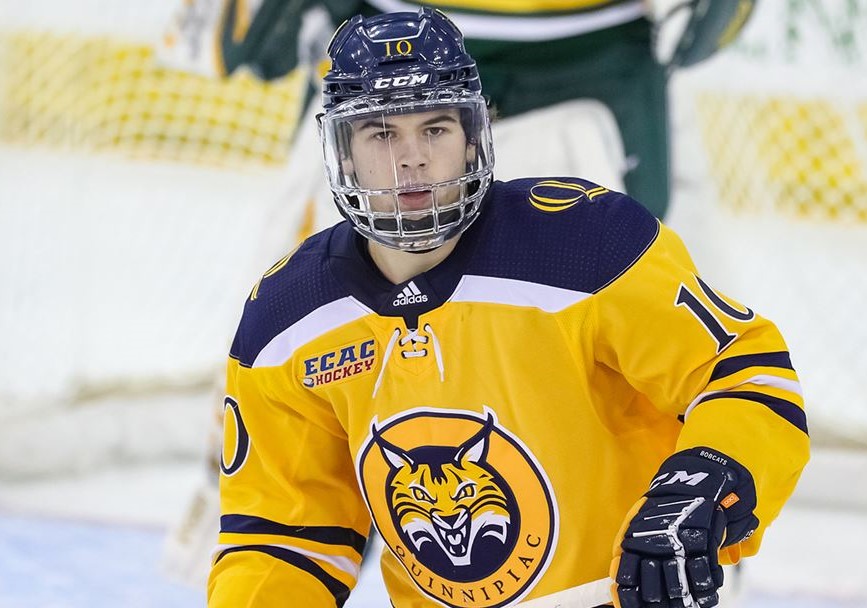
Each week during the season, we look at the big events and big games around Division I men’s college hockey in Tuesday Morning Quarterback.
Paula: Well, Dan, it was a wild weekend for the top teams in college hockey, resulting in a new No. 1 and some rearranging of the top 10 in the USCHO Men’s Poll.
Thirty-eight voters agree that Minnesota State is the best team in college hockey — this week, anyway — after the Mavericks absolutely handled St. Thomas, outscoring the Tommies 14-0 in a two-game sweep.
Minnesota Duluth and Qunnipiac garnered 11 votes between them after the Bulldogs split with North Dakota and the Bobcats shut out St. Lawrence 8-0 and tied Clarkson 2-2. What’s interesting to me is that Michigan still received a single first-place vote after losing two OT home games to Notre Dame — who climbed from 14th to Not. 8 with the road sweep.
Last week on USCHO Live! Jim Connelly and Ed Trefzger talked with Michigan’s Mel Pearson, who addressed some of the issues his young, talented team is having, including that sophomore class playing in full arenas for the first time this season. All four of Michigan’s losses have been at Yost, a barn with a fantastic atmosphere that opposing teams often claim to relish. The Irish clearly enjoyed that hospitality.
What I am wondering — still — is how many pandemic-related intangibles are affecting the wild ride we’re seeing nearly weekly in the top 10. It’s also fascinating to see perceived strength of opponent play into rankings, win or lose. How are you seeing any of this play out?
Dan: This is an excellent question and I am honestly stumped at how to fully answer it.
There’s a part of me that thinks last year was a debacle and nothing that came out of it matters to how this year is being played. This is a fresh slate with teams being able to practice on regular schedules. The team-building drills and exercises are back in full swing, and after a month or two, the identities are forming. That’s something we would expect in any year, and the first year out of the pandemic, in that regard, would illustrate how much of a return to normal we have.
But it’s not that clear cut, nor is it that easy to answer. A good chunk of teams lost last year in a number of different ways, and we’ll never be able to measure how much playing through the pandemic’s height impacted cultures and players’ willingness to continue playing for teams. The new transfer rules made it easier to move around, anyways, but we’ll never know how many of those players were just plain exhausted by the end of the season. As a result, I don’t think we’ll ever be able to figure out how many intangibles, which is a great term to use, are still impacting programs.
You also bring up a great point about Michigan that’s also pretty tough to answer. I’d love to sit back and talk about the stress of a team that’s at home, but I think it’s a hard-to-measure combination of factors. Michigan is so talented and is expected to crush every opponent, but it’s hard to tell if it weighs on a team or is a factor when it plays against teams who are that good. I think that’s more case-by-case about the team, the opponent, the factors and the intangibles to the individual matchup than it is a broadstroke conversation.
Because of the pandemic, everyone needed to learn how to go into an arena with fans for the first time, and where some people have relished it, others have simply not known how to react to it. I’m not sure what’s happening with Michigan – I’m not saying it’s one way or the other – but I do know that even as an employee or a journalist, there’s a lot that I’m still not used to experiencing again.
When it comes to the rankings, though, I don’t know if the pandemic is involved moreso than the recency bias that’s always in every week, and I more see that as a compliment to the best teams that are tightly packed together. I know I dropped Michigan out of the top four or five spots, but my vote for Quinnipiac at No. 1 was as much a compliment to how the Bobcats look right now than it is a knock against Michigan or St. Cloud, who I had at No. 5 and No. 6 behind Minnesota Duluth, Minnesota State and North Dakota. That’s a murderer’s row of teams, and they all have a very good case as the No. 1 team.
The bias aspect, though, is something I think we need to talk about more frequently because I think it genuinely hurts a team like Omaha, which is tied for fourth in scoring offense and tied for ninth in scoring defense, has an 11-3 overall record, and can’t seem to get higher than ninth in the poll. The Mavs deserve more, in my mind, but they still don’t have that same glamour that Michigan or North Dakota have. The same goes for Cornell and Harvard, which are two teams everyone forgot about because of the double whammy of starting later than everyone AND not playing last year.
Bias has always been a touchy subject for me, though, and it’s largely because I think certain leagues (ahem, Atlantic Hockey) have never gotten their proper due or respect. I compared Atlantic Hockey to the WCHA two years ago and put a ranked team up against RIT in both overall record, scoring offense, scoring defense, non-conference record and some other situational numbers while removing the teams. RIT barely had a vote, but the WCHA team was ranked inside the top 18 in the nation. I bristled at it at the time, much like I did this year when Bentley went 2-2 with wins over Ohio State and Boston College.
In the poll that was released two days later, BC, which had just beaten Northeastern in a tremendous game, dropped from No. 6 to No. 10, likely because of the loss. Ohio State had 30 votes and was just outside the No. 20 spot held by, ironically enough, Northeastern. Bentley, meanwhile, had four votes. That, to me, was an indictment of how voters viewed Atlantic Hockey, a league that’s beaten teams in the national tournament almost annually and put Air Force into a No. 3 seed as recently as 2018.
I hope all of this makes at least some sense, but wow, there was a lot to unpack there. I think I covered it all. Anyways, we’re hot and spicy out of the gate here.
Paula: Spicy, indeed!
That wasn’t my intention, but I’m glad you bring up the inherent biases. It’s the difference between a poll in which people offer an educated opinion about what’s going on in a given week and the PairWise Rankings, which is data-driven. Ultimately, the poll doesn’t matter except to provide us with good points from which to launch these discussions, right? At the end of the season, it’s the PWR that matters the most.
And that, coaches would argue, is the thing: play the games, take care of business on the ice, and the end of the season will take care of itself.
As for this week, I gave Minnesota State the top spot on my ballot for the thoroughness with which they dispatched St. Thomas. There’s a lot of merit in your first-place vote for Quinnipiac based on their drubbing of St. Lawrence. What’s interesting to me, though, is that we’re both reporters who often champion leagues we perceive as under-served by the general college hockey media. Also interesting is the mix in the top five in the poll — CCHA, NCHC, ECAC, Big Ten, NCHC, in that order – while three NCHC teams are represented in the PWR, plus Minnesota State and Michigan.
We may be going around and around about the same thing, and instead of life imitating art, at the end of the season the converse may be true: art (the poll) imitating life (PWR).
Dan: That’s where I stand with it, but I’ll readily admit that I do love looking back over the old polls as a screenshot into what we were thinking at a time or place. It’s always fun to look through our USCHO.com poll archive, where you can literally see any week from a past year, and see how people were thinking. It offers perspective that we, as writers, use to craft our arguments whenever talking about which teams are on streaks or look good. That’s why it still has an important place opposite the Pairwise, which I guess leads me to my next question for you.
We didn’t have the Pairwise last year because nonconference scheduling was nonexistent in a COVID world. It led to a conversation about how that opened the possibility of introducing an old-style, smoke-filled rooms of people figuring out which teams belonged in the tournament and which ones didn’t, and I hope, somehow that, the Pairwise is used in conjunction with our poll to determine a field of teams as we move forward. I think using math is great, but we’ve seen that the Pairwise itself is flawed.
I look at the WCHA and how it couldn’t get certain teams into the tournament for years because its collective PWR dragged its coefficient down, and the best teams in Atlantic Hockey dealt with a similar situation. Coaches and leagues obviously need to win their way into the tournament, but if the entire league can’t do it from top to bottom for a variety of reasons, then we’re left talking about it on an annual basis.
I would love to know if there’s a way to evolve and to merge art with life. Is there a way to use the PWR to form a pile of teams that then get analyzed by a committee, or is the mathematical equation simply the only way we can do it?
Paula: Data-driven decisions, all the way.
Think of how much more sense college hockey would make if things like data at the gate were taken into consideration for regionals, for example. There is so much evidence that shows that non-campus sites for regional play are a bust. It’s too early in the season to gripe about this – especially when we think of the restrictions of a year ago – but there is a lot that college hockey gets right, but regionals ain’t it.
Selection, though, is. You and I can make a pretty good argument for nuancing some of the bubble selections to allow for factors other than conference strength to help pick the field – and let me make it clear here and now that I know that “conference strength” isn’t a thing but that strength of schedule is – allowing chances for some deserving teams to participate who are often overlooked, but that’s also an argument for keeping it to the numbers only, to take away the bias. However the committee does what it does, there will always be someone unhappy.
Look at the poll. I rewarded Minnesota State for sweeping a weak St. Thomas team while Omaha handled Alaska really well and fell in my poll – sorry Mavericks – because I moved North Dakota up. The Mavs didn’t deserve to drop a spot in my poll, nor did the Buckeyes, who didn’t even play. I had to move North Dakota up and this is why I’m glad a committee of humans other than me uses something like math to select the field.
I want to pivot here to the news that Boston College is postponing games this weekend against Notre Dame and Harvard because of COVID protocols. As someone who lives in Michigan, the state leading the current U.S. COVID surge with truly alarming numbers, I can’t tell you how dismayed I am to see this happen in Massachusetts.
BC is in Suffolk County, which has a one percent COVID positivity rate. Honestly, I expected this – but not in Boston. What do we take away from the news that a team that played at home last weekend in a place with one of the lowest COVID positivity rates in the country needs to reschedule a weekend out of the proverbial abundance of caution?
Dan: In terms of what it means to Hockey East, Massachusetts or Boston College (a school that, in full disclosure, I work with, even though I don’t know anything about this situation, just felt it was worth a disclaimer there) – or even Harvard or Notre Dame, who were subsequently rescheduled – I simply don’t know.
I’m really proud of Massachusetts and the way we handled COVID-19 (we were one of the first and hardest-hit states when we didn’t know what we didn’t know) and as a resident of the Commonwealth and more specifically Middlesex County, I’ve never gone to an event and felt unsafe given the way it’s been handled in this state. There’s a knowing risk involved any time I step out anywhere, especially since we know that the Delta variant that’s most prevalent makes some vaccines diminish their effectiveness, but with the indoor move of activities as temperatures are getting colder and the natural diminishment of vaccinations from last winter, the state opened booster eligibility to all adults aged 18 and older with the recommendation to acquire the booster if your vaccine status was older than six months. So it’s worth noting that I think the state’s rate back down where it belongs as vaccination rates and booster rates raise like they did when we first went through the process.
That said, COVID is still very much a presence in our lives, and the rate of infection in Massachusetts topped three percent over the last seven days after it cratered around November 1. I do think that in the post-COVID era, I’d rather see a school postpone out of an abundance of caution rather than proceed and potentially run the risk of infection with another team.
I think back to the days when players and coaches would gut through games while suffering from the flu or a viral infection or some other sickness, and I remember getting sick after the Brown-Princeton triple overtime playoff game. The next week, I worked the Bentley-Robert Morris series with what I thought was a bad cold, but I was practically shivering a cold sweat in the broadcast booth while I ate raw honey and sucked on lozenges to help my throat get through it. That was a totally normal thing to do in those days, but with what we know about the coronavirus and COVID-19, that’ll never happen again. That’s a good thing for everyone involved, and that’s a perfect example of when a school announces “an abundance of caution,” I think.
Again, I don’t know what’s going on in this instance with BC, but I’ll just reinforce that it’s better to be safe than sorry in 2021.
All of that said, as confident as I am in things in Massachusetts, I understand how I live in a bubble out here, and I don’t know what to expect from other schools or other states. I’m always going to be worried about it, but all I hope is that this reinforces the best practices regarding the coronavirus. I wish for people to get vaccinated wherever and whenever they can so these embers can be easily stamped out, and if they aren’t vaccinated, follow the CDC guidelines and recommendations to minimize both the risk of infection and the ongoing spread across the country. We all want to have college hockey, and every step is important to keep things moving in the right direction.
From all of us at USCHO.com, Happy Thanksgiving!


